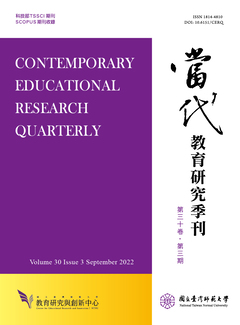

研究目的
隨著社會民主與多元發展,弱勢者的教育權益逐受重視,但隱 性的弱勢族群仍倍受忽略。為了能培養學生對不同文化及隱性弱勢 群體發展正向且積極態度,本研究整合多元文化教育學家 Banks 的 「減少偏見」構念和社會心理學家 Darley 和 Latané 的「旁觀者介入 模式」,設計「為弱勢者發聲」課程,目的在探討參與者對於偏見 覺察力與旁觀者介入知能的學習內涵與歷程。
研究設計/方法/取徑
本研究取向為詮釋現象學,採立意取樣邀請 10 位高中生接受 6個課程模組共 12 小時的「為弱勢者發聲」課程,並蒐集課堂討論、 作業文本和訪談資料。
研究發現或結論
本研究發現旁觀者介入模式當中的「注意」與「衡量」適合運用偏見察覺方法來進行培力,其後才能啟動旁觀者介入之「承擔」、 「方法」和「行動」。而本研究設計「為弱勢者發聲」課程的學習 內涵包括:洞悉日常生活的偏見、破除刻板印象、偏見覺察力、旁 觀者介入行動的知與行;課程的學習歷程包括:發展旁觀者介入的 思維、建構旁觀者介入的策略、維持旁觀者介入的作為。
研究原創性/價值
本研究發現性別、外貌、身材、個性等因素經常造成青少年在 同儕團體中的弱勢處境,此種隱性弱勢在教育領域當中的資源少於 族群或身心障礙等多元文化群體,值得教育者與研究者關注。最後, 本研究提出教育實踐之建議,並提出未來研究方向之建議。
Purpose
With the recent increase in social support for democracy and diversity, the educational rights of disadvantaged groups have received more attention, but there are other groups that are still marginalized in the society. To cultivate positive and proactive attitudes in students towards diverse cultures and multicultural groups, this study designed the “Speaking Up for the Disadvantaged (SUD)” course by integrating the “prejudice reduction” concept proposed by Banks, a multicultural education researcher, and the “bystander intervention model” proposed by Darley and Latané, social psychologists. The purpose of the study is to explore the learning processes and outcomes of participants' prejudice awareness and bystander intervention.
Design/methodology/approach
This study adopted the approach of interpreting phenomenology. Ten high school students were selected via convenient sampling to take 12 hours of the SUD course that consisted of 6 units. Classroom discussions, homework and interview data were collected.
Findings/results
The study found that the learning outcomes of the SUD course included understanding of everyday prejudice, stereotype deconstruction, prejudice awareness, and the knowing and doing of bystander intervention. The learning processes included developing the perspectives of bystanders, formulating the strategies of bystander intervention, and maintaining the willingness to act as bystanders.
Originality/value
This study found that factors such as gender, appearance, physique, and personality often position adolescents at a disadvantage by their peers. Some of these factors are often overlooked in the field of education and require more attention to ensure educational equity for all. This study also proposes educational practices and directions for future research.

This work is licensed under a Creative Commons Attribution-NonCommercial 3.0 Taiwan License.
Center for Educational Research and Innovation, National Tawain Normal University
162, Ho-Ping East Rd, Sec. 1, Taipei, Taiwan | Tel:+886-2-7749-3670 | E-mail: cerecerq@gmail.com
CERI | NTNU | E-mail Alerts | Open Journal System
© 2014 CERI-NTNU
